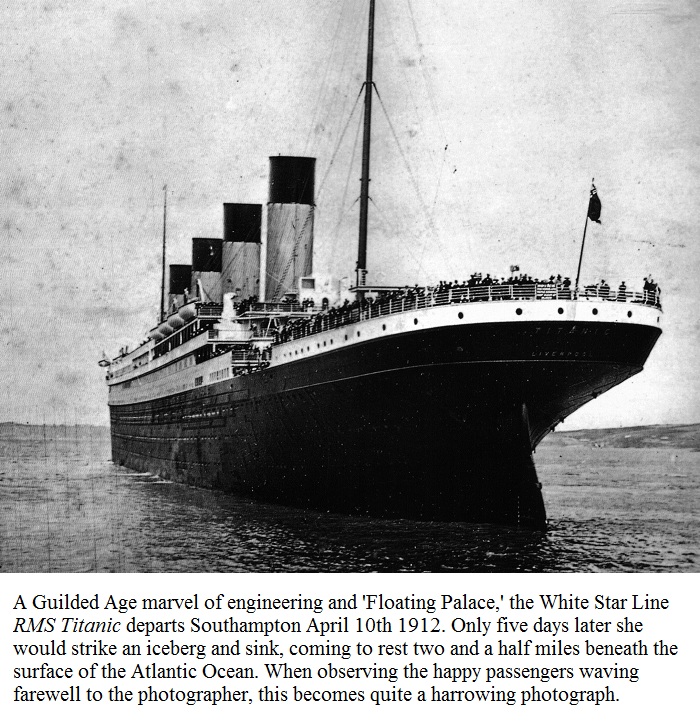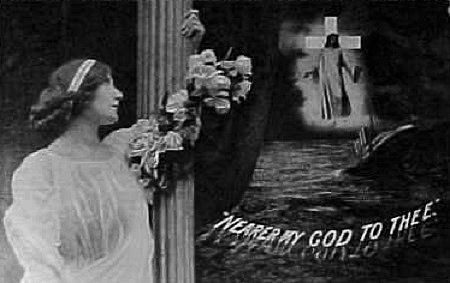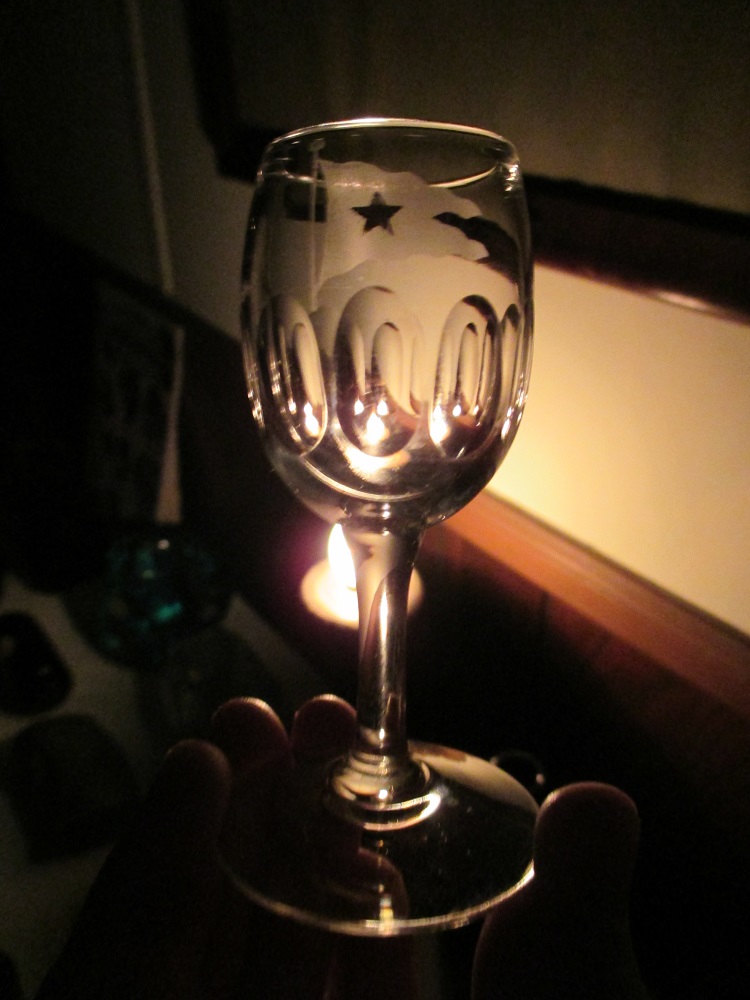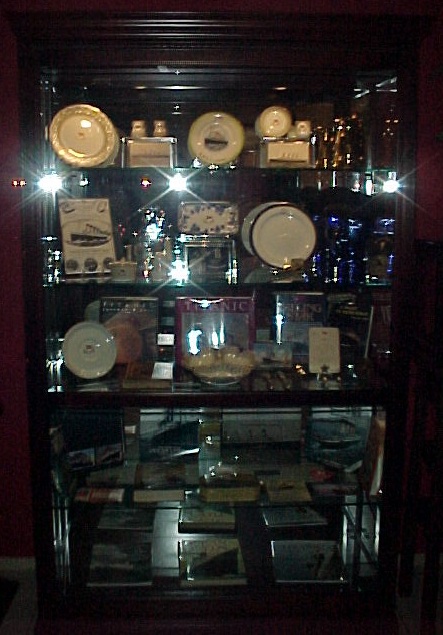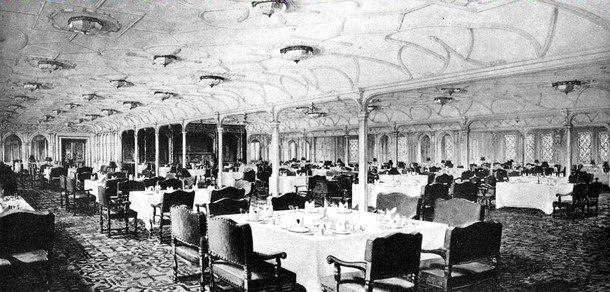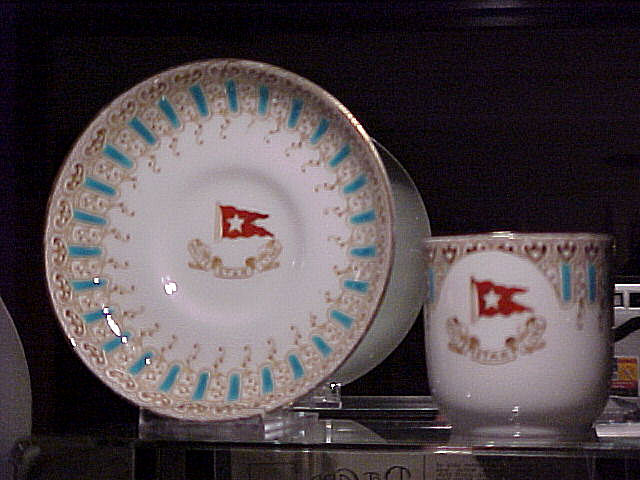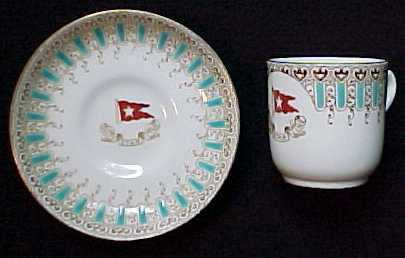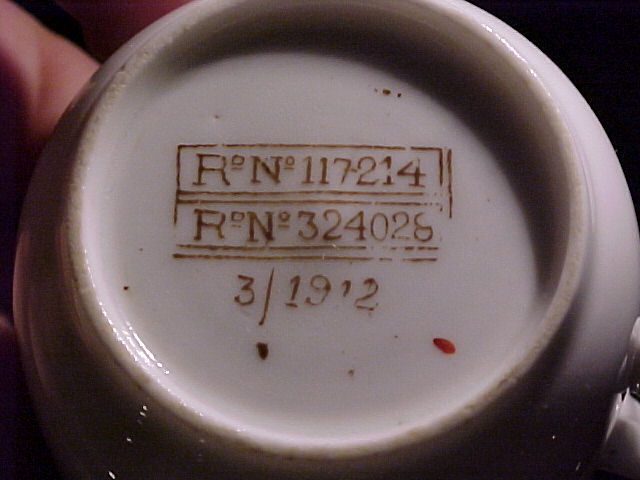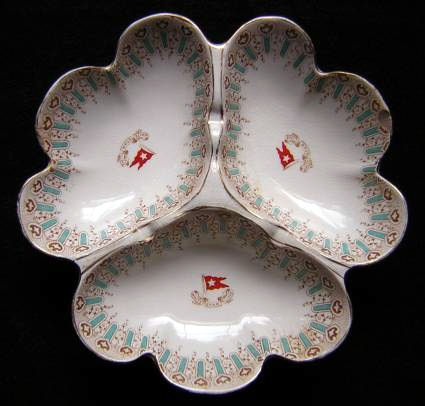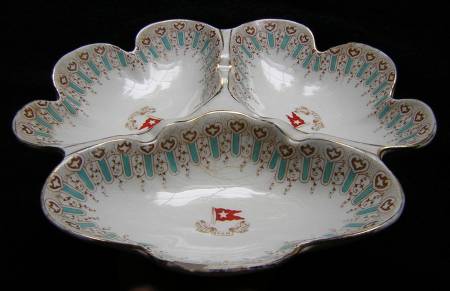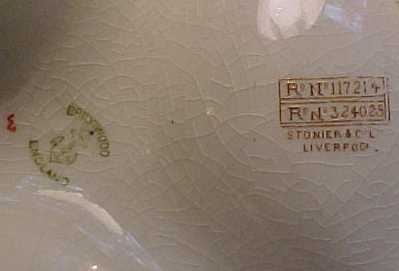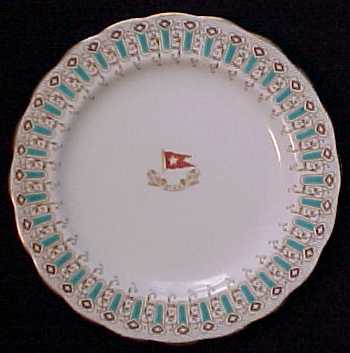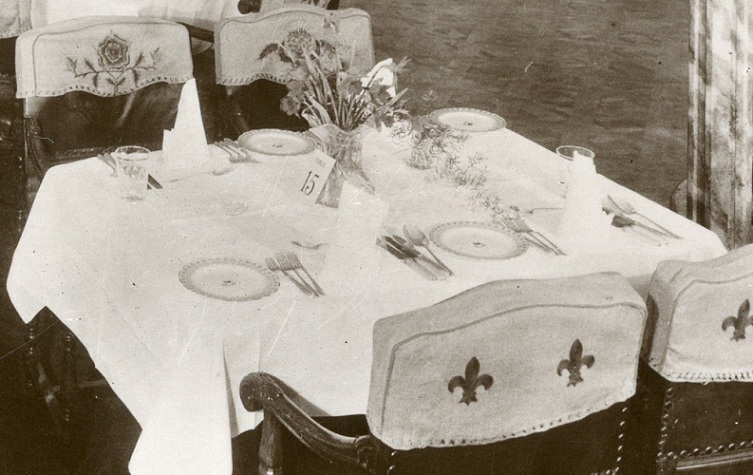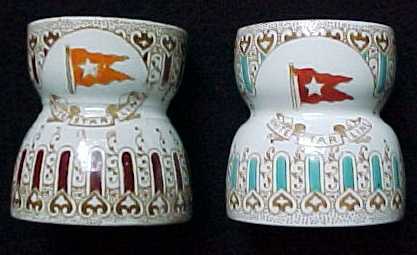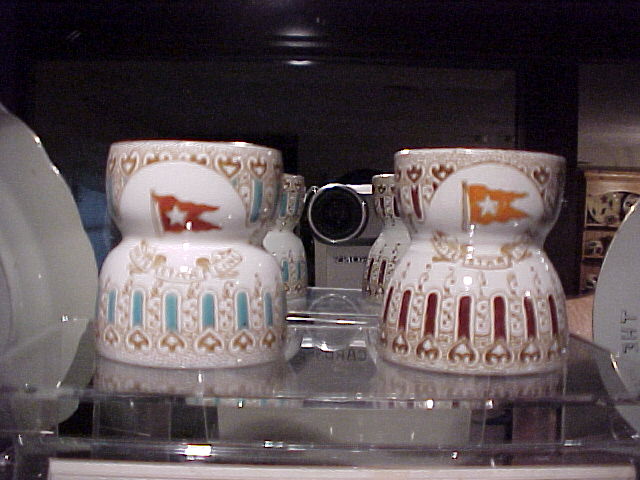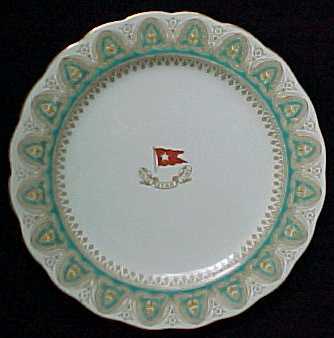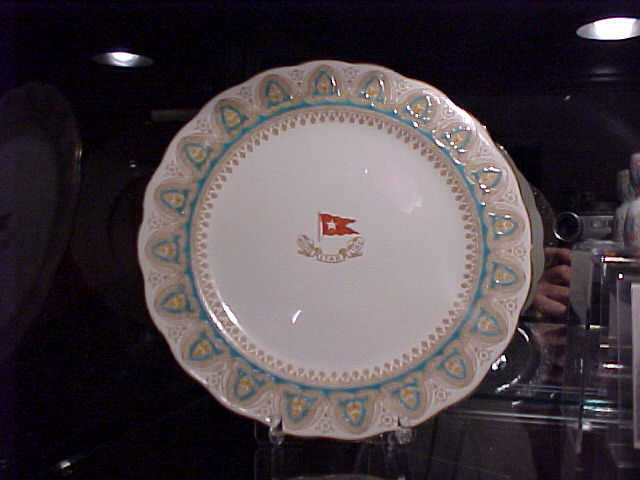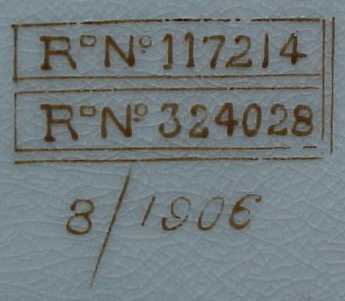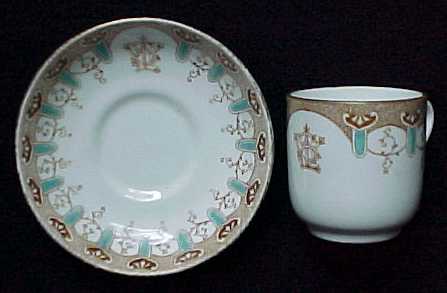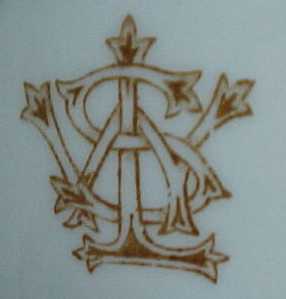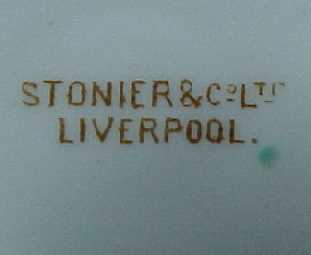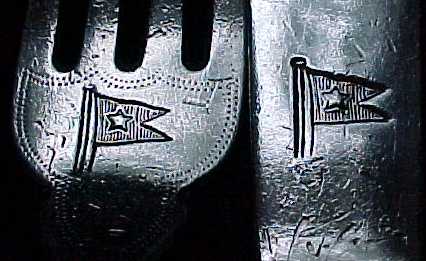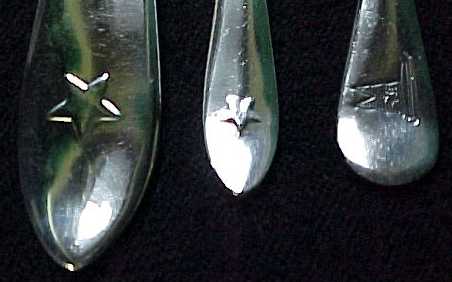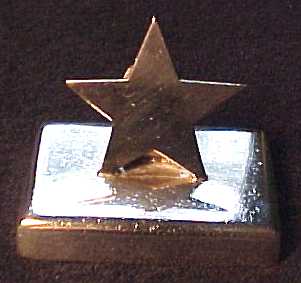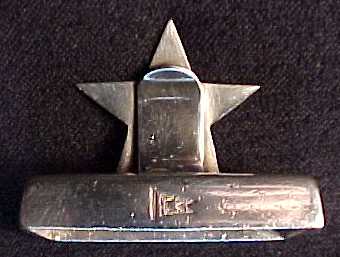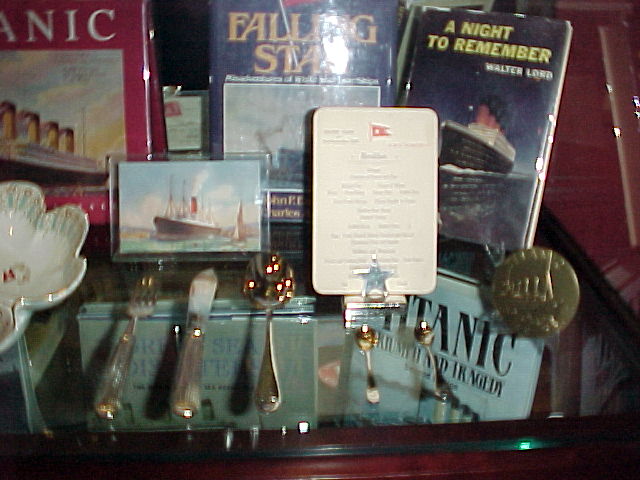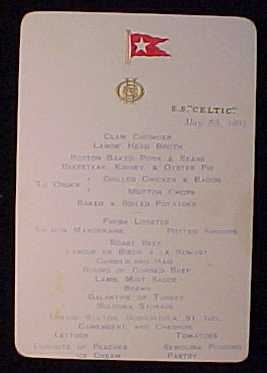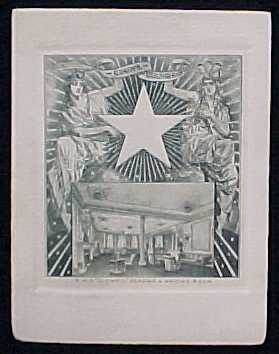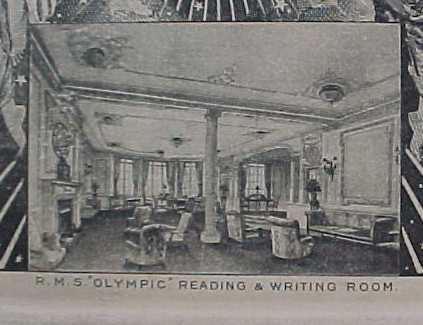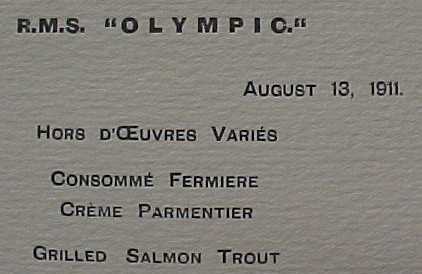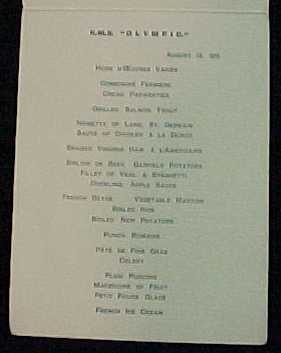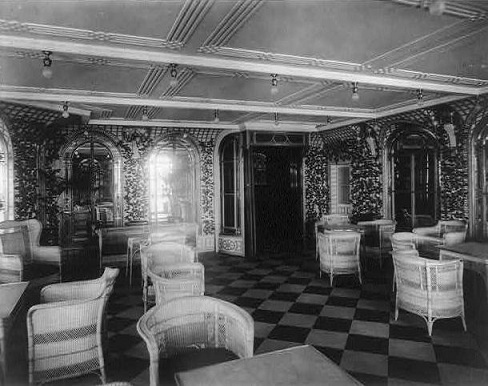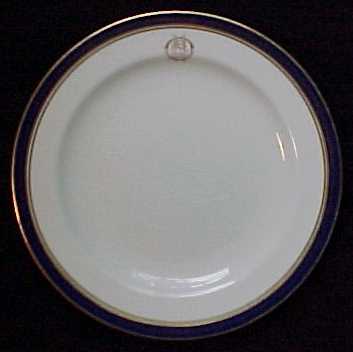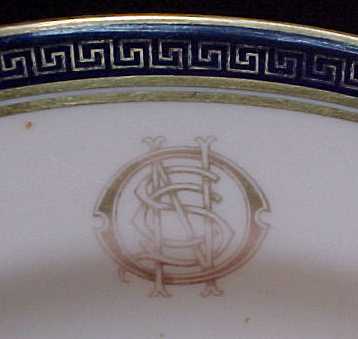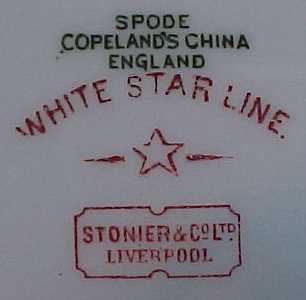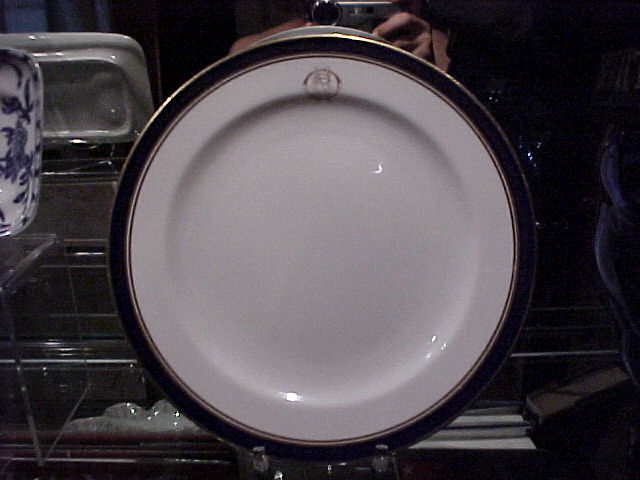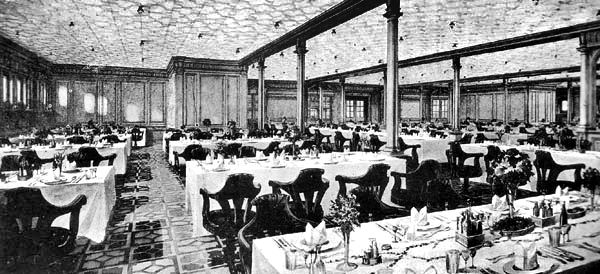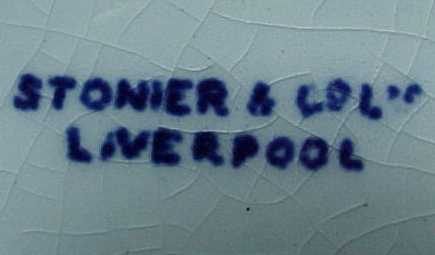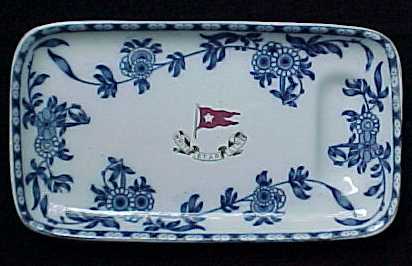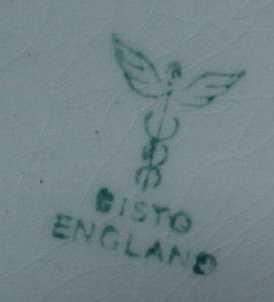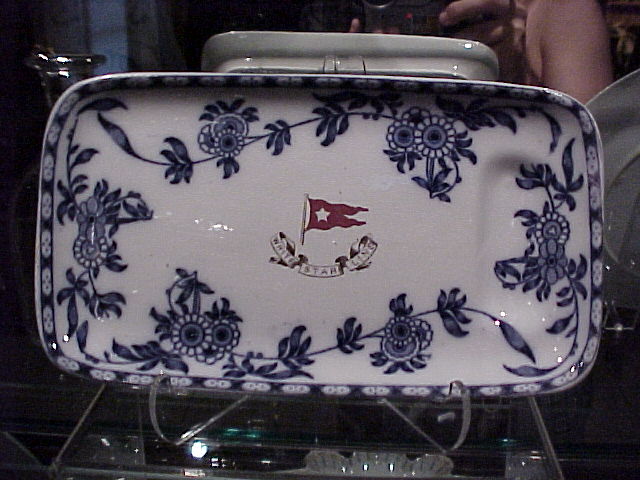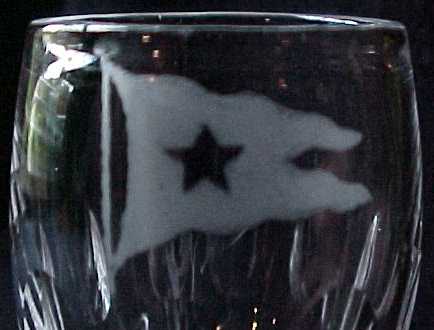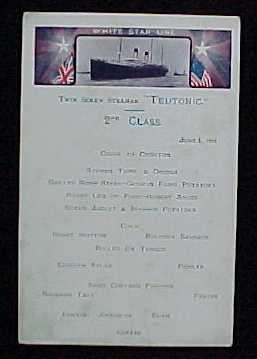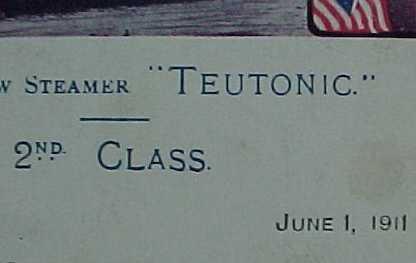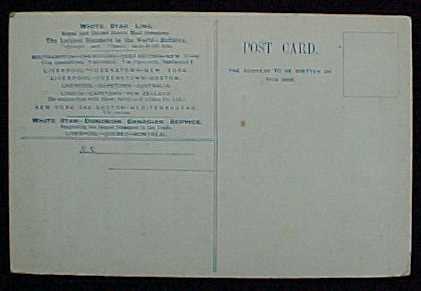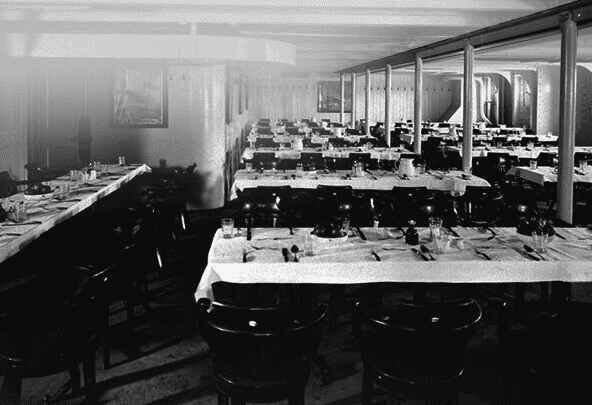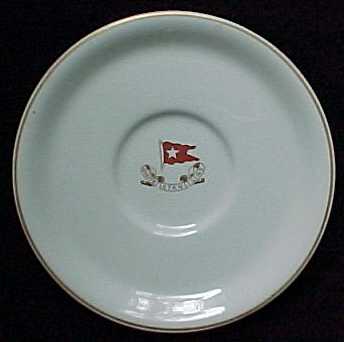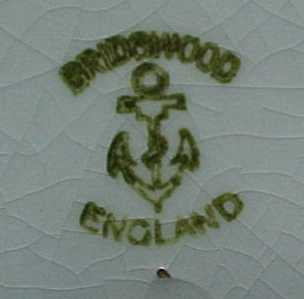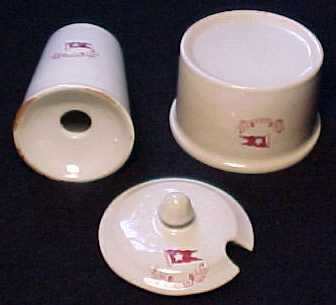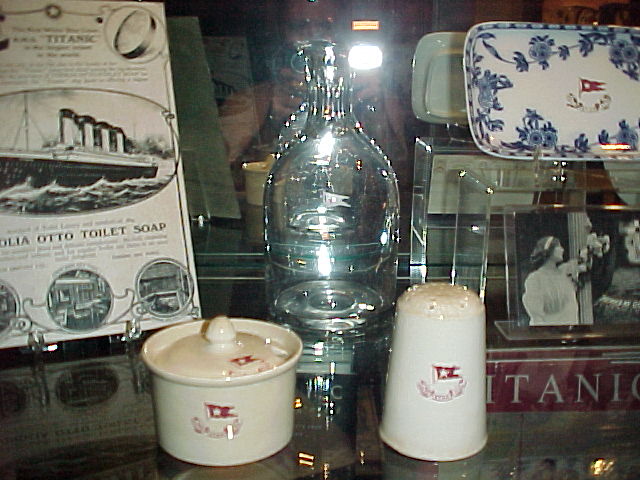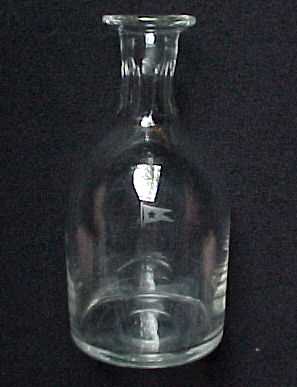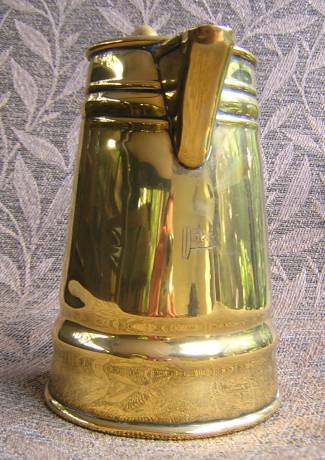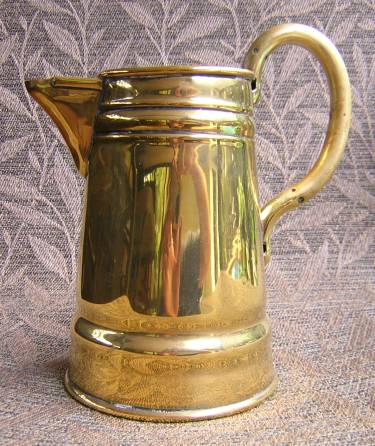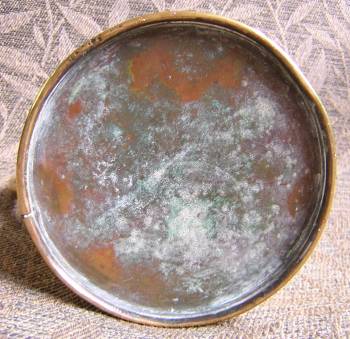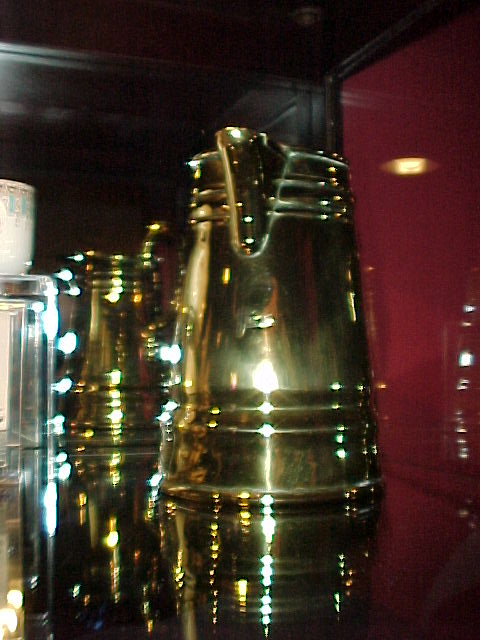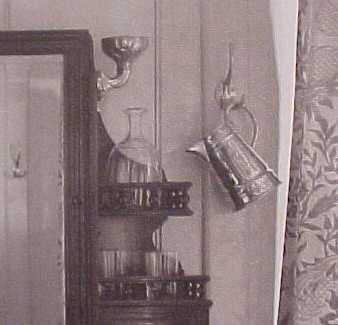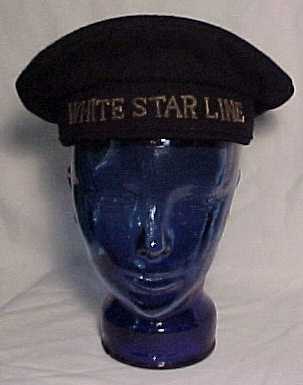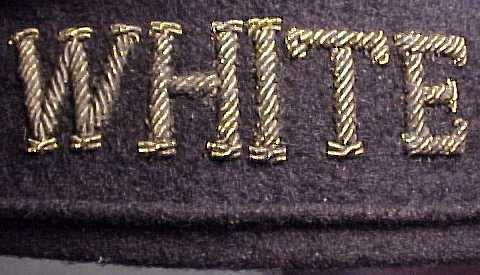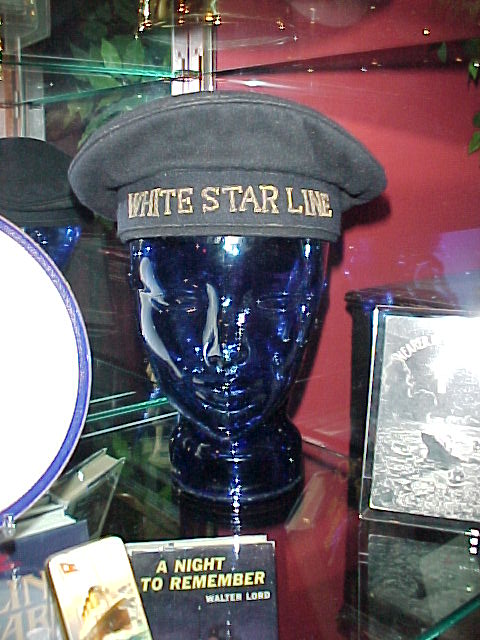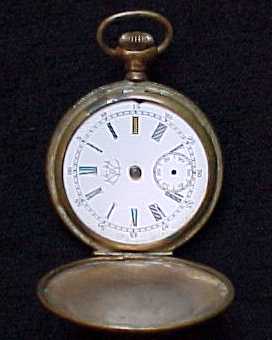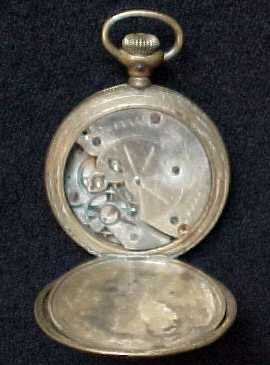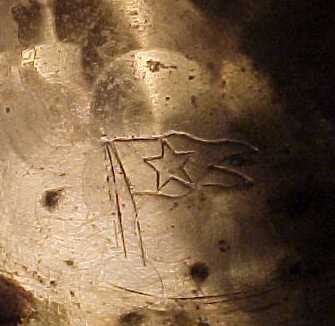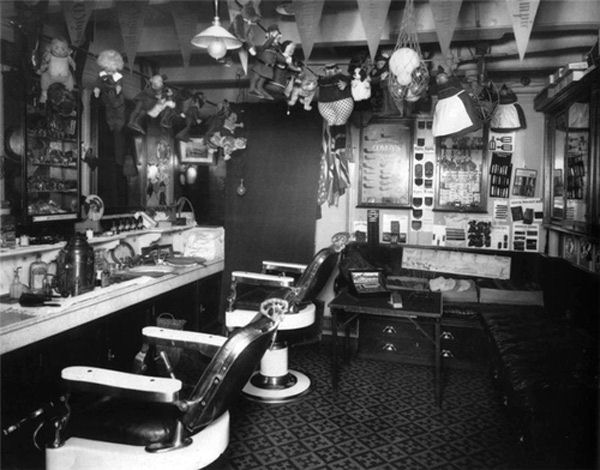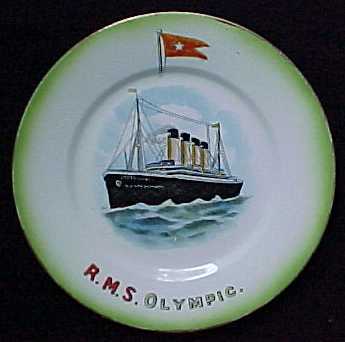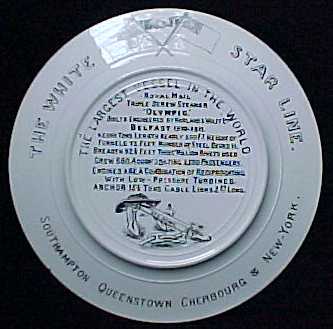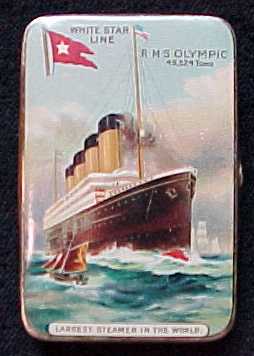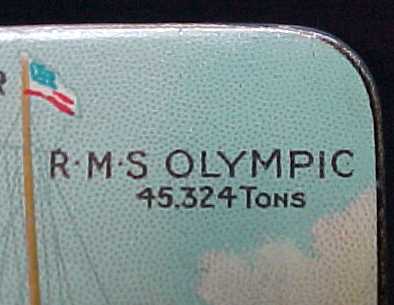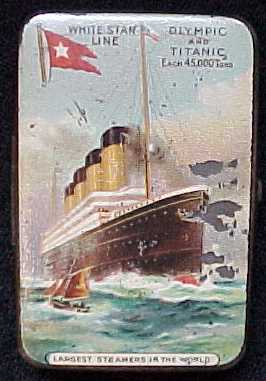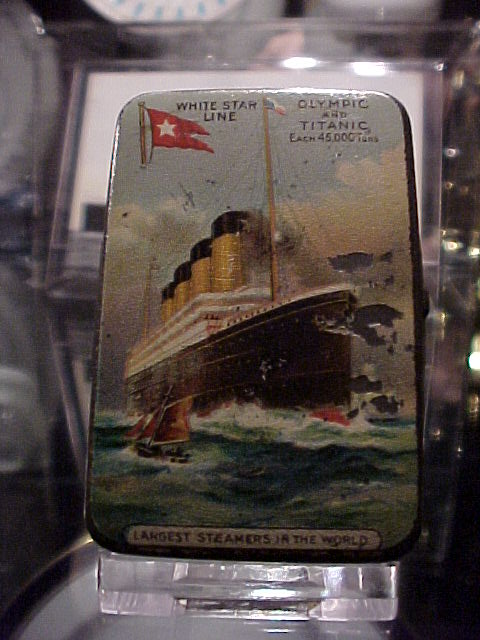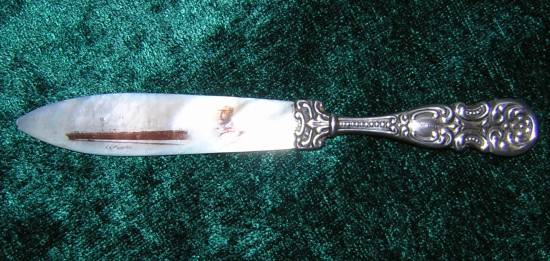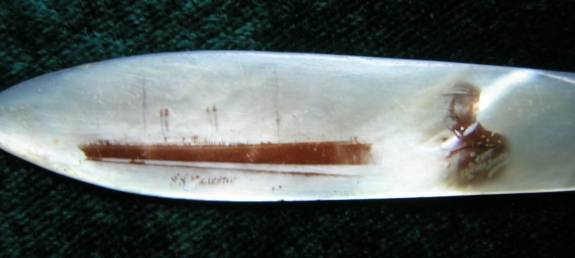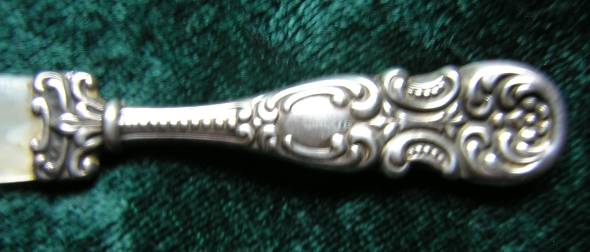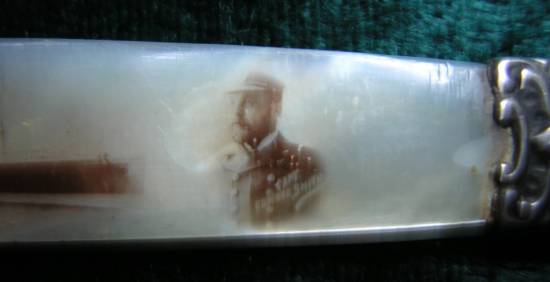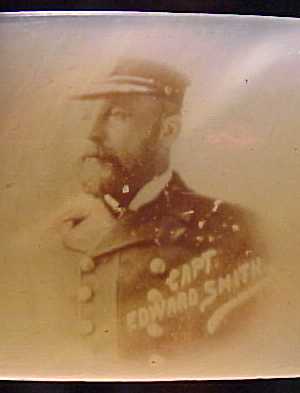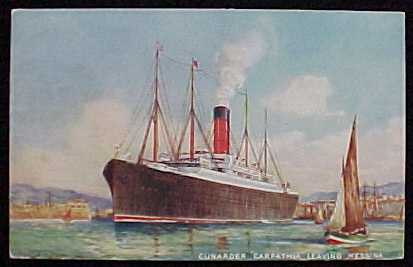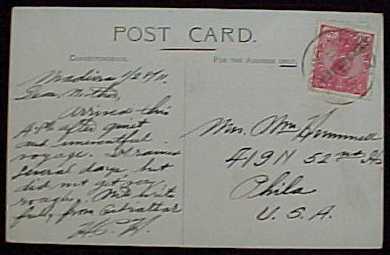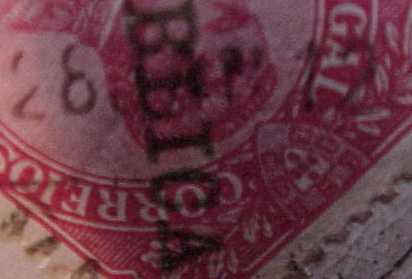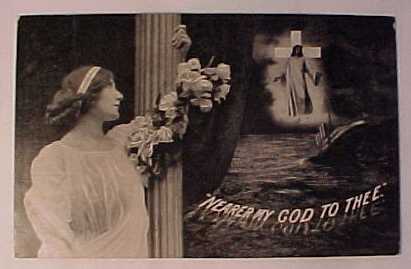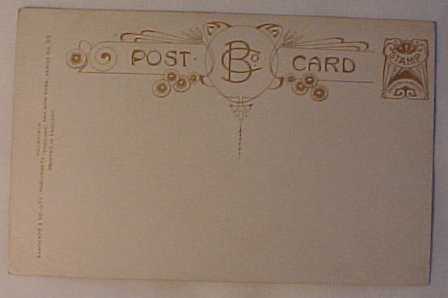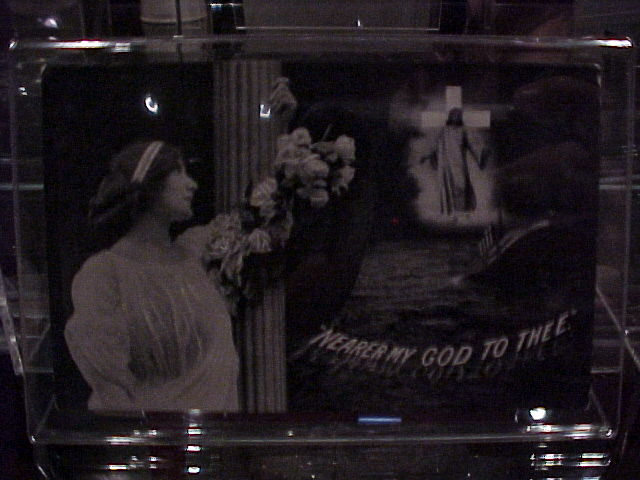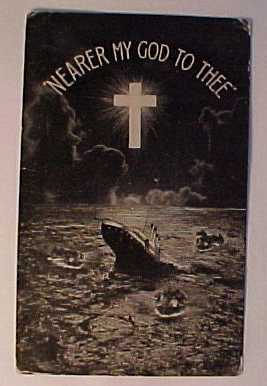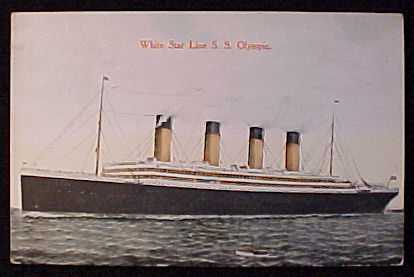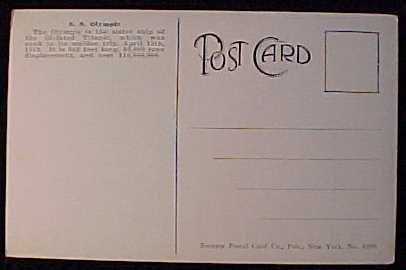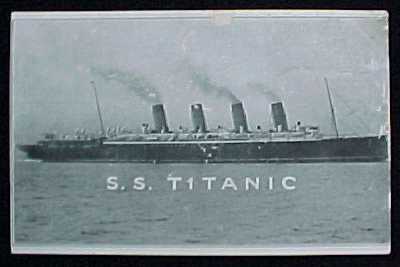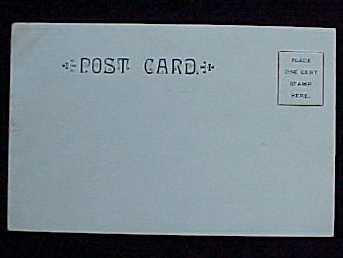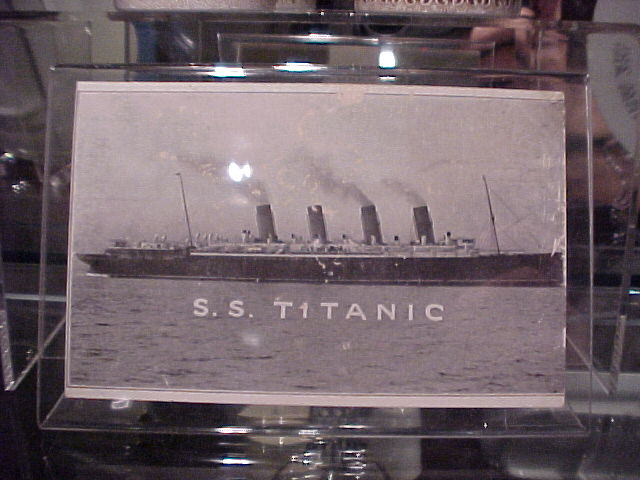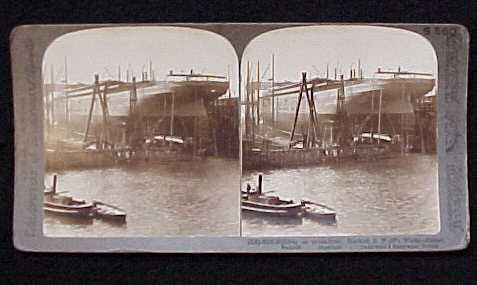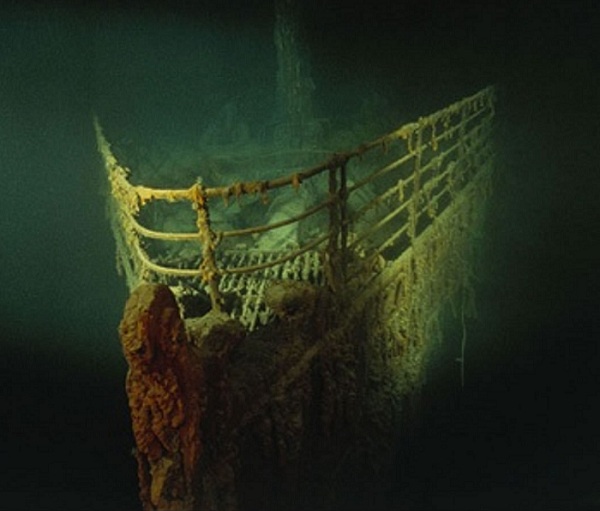The veil was torn asunder
‘Tween the hours of twelve and one
No change, no sudden wonder
Could undo what had been done
The Watchman lay there dreaming
At forty-five degrees
He dreamed that Titanic was sinking
Droppin’ to her knees
‘Tempest’
-Bob Dylan 2012
The Richter Titanic White Star Line Collection
The entire Titanic White Star Line Collection shown below was born out of my love for old glass. Back in 1997 I found myself in a antique shop just a few doors down from my own antique store, on a slow day, just poking around in this shop that had glass everywhere.
Among shelves of endless glass clutter, I found myself staring a trio of flint glass cordials, each with circular lobe cuts near the base of the cup and above that a very curious acid etched dovetailed flag with a star in it’s center. The three turn of the century cordials were priced $12.00. Realizing what they were in an instant and placing them on the counter, the friendly store owner said I could have the three for $10.00. I auctioned one on eBay not long after and it sold for over $750.00. After that I was hooked.
It’s still hard to imagine, just poking around for old glass resulted in the Titanic White Star Line Collection shown below.
The First Class Dining Room
Brownfield Wisteria Pattern China
The china used on sister ships Titanic and Olympic were stunningly beautiful and featured transfer designs that were painstakingly hand painted. The red flag in the centerpiece White Star Line logo was always hand painted, as was the the turquoise in the different patterns, resulting in tableware that was absolutely gorgeous and worthy of any palace. (When they referred to Titanic as a “Floating Palace,” they weren’t kidding.)
Let’s start with the highest prized china set in the collection, a demitasse cup and saucer in the “Wisteria” or “Brownfield” pattern that, made by Bridgwood, actually was a Titanic set; made for Titanic, yet never made it on board as it was stock china to replace what got worn or damaged from use. Had she not sunk on her maiden voyage, this set would have eventually been used on Titanic. Note in the below pictures the beauty of the set and the base British Registry date markings; RN 117214 (1889) and RN 34208 (1898) and below those the date you almost never see: 3/1912. March of 1912 was the fitting out deadline for the ship and the order placed for the First Class china from distributors Stonier & Co of Liverpool had those markings and date code on the base of the Titanic’s First Class Brownfield Wisteria patterned china.
The above picture (taken many years ago, as all were) is a tad blurry, but shows the set on display. The below pictures show this lovely set in a bit more detail.
The below picture of the cup base illustrates how the date and registry marks are done in brown transfer just like the pattern and logo on the tops of the pieces.
Not all items in this Collection were from Titanic/Olympic, but I was as focused on acquiring pieces that were as close to the 1911-1912 period and items that were only used on those “Big Three” (Titanic/Olympic/Britannic) as much as possible. Britannic was originally named Gigantic, but after the Titanic tragedy, White Star Line officials aptly gave her a more humble name. Britannic did not see much passenger service and ended up as a hospital ship in WWI and hit a mine and sank.
Pictured below is quite the grand piece; a three part condiment Brownfield Wisteria pattern serving dish, extremely rare, as (I believe) there were only three on board at a time. These large serving dishes were only made for the “Big Three;” Titanic, Olympic, and Britannic. Competing with Cunard Lines, which were noted for speed, White Star Line commissioned the “Big Three” to surpass Cunard in luxury. A dining steward would walk around with one of these large elegant dishes proffering condiments to the first class diners as these dishes were too large to be placed on the tables. (These serving dishes were heavy and measured about a foot across.) What’s really fascinating to note; when the artifacts were taken from the Titanic wreck site, only one of these was found and it was worn to just bare white rough porcelain. I acquired this beauty in Southampton, England, in 1999 for many a “quid,” despite a chip or two on the edge, as just acquiring one of these in any condition is in itself, quite a major feat. It’s a most beautiful and impressive piece.
Note the double back stamp above, Bridgwood made and decorated the porcelain which was then distributed by Stonier & Co of Liverpool. I could almost say stoneware in this case, as this was a very heavy and durable piece. White Star Line china was fired many times, initally, then for the brown transfer, then again for the gold leafing on the rim, and then even again for the turquoise tongue and flag painting, all hand done.
Shown below is a Brownfield Wisteria patterned 8″ side plate I chanced upon dating to around 1910:
Note the pre-set table aboard Titanic sister ship Olympic, there sit the 8″ side plates in the Brownfield Wisteria pattern.
First Class Dining and Stateroom Service
The two elegant eggcups featured below are very interesting; note the turquoise coloring for the Brownfield Wisteria pattern and then note the most unusual burgundy/brown painted tongues and the orange painted logo flag in comparison. The brown painted tongue pattern was used for stateroom service. The turquoise was for dining service only.
Crown Pattern Dinner Plate
Now the most unusual, beautiful, and intricate of the first class dining patterns; the colors are similar to Brownfield Wisteria, yet more colors have been added to the hand painting of Crown pattern. (Also referred to as “Celtic,” or “Acorn” pattern by collectors.) I have only acquired a dinner plate and have seen this pattern on one bowl, but mysteriously, never on a cup and saucer. Having never seen a dinner sized Brownfield Wisteria pattern plate; I know this was the dinner plate used with Brownfield Wisteria. The entree was served as a work of art, as the richest folks ate from these. The dinner plate I had is featured below. The plate is backstamped with the date: 8/1906.
WSL Initial Logo
Another first class pattern, and one for which I never could resource a name to, resembles Brownfield Wisteria and has a entirely different logo which intertwines the WSL letters of White Star Lines is shown below in a demitasse set and I cannot recall where I got it. It may have been for crew/officer use only, or may just be earlier, and date to the 1880’s-90’s. I was told by a dealer in England that the greener the hand painted tongues are in the pattern, the older the piece was, as the turquoise blue was what the color evolved to after 1900. The Brownfield pattern was first used in 1889. The backstamp markings on this piece do not include a date of manufacture.
White Star Line Silverware
The tableware silver for White Star Lines first class service was made by Elkington Plate and also (larger serving platters and bowls) by Reed & Barton. The below fork, fish knife, large serving spoon, and small mustard spoons were made by Elkington Plate. These were both beautiful and quite heavy and durable. I remember acquiring the large serving spoon on Portabello Road in London in 1999.
The menus for first class were beautifully done and were held in elegant and heavy silver plate menu holders as seen below with a picture of my display with it holding a menu.
The menus themselves were either single sided thick cards or parchment type paper that folded open. These featured great detailed illustrations; in those days no expense was spared. Below is featured a menu card from the SS Celtic dated May 5th 1904, and a larger fold open dinner menu from Titanic sister ship Olympic dated August 13th 1911. Note the intertwined lettered logo below the flag, this was the logo of White Star Line’s parent company: OSNC, which stood for Oceanic Steam Navigation Company. (And yes, it is done in real gold.)
The Al a Carte Restaurant
Before we move on to the second class dining room, there’s something special to share. Only on the Titanic and Olympic was there a separate restaurant for first class that featured made to order meals and served whether the dining room was open or not. This lovely place was called The Al a Carte Restaurant and was quite beautiful. The china used there was a bit higher end than even first class as the below dinner plate (always my favorite) will illustrate. It was made by Copeland Spode and featured the not often seen parent company logo OSNC. The gold Roman Key on the cobalt border is total class.
Second Class Dining Room
On White Star Line ships, second class was the smallest of the three classes, making the acquiring of any items harder and the pieces themselves, much more rare and dear. The china pattern is no less lovely than those of first class in my opinion, but it is strikingly different. The pattern name is Delft or sometimes referred to as “Grapevine” by collectors. The pieces are stunning with the ‘flow blue’ type pattern combined with the deep red contrast of the flag logo. The asparagus dish was acquired in Southampton, England, in 1999. Both were made by Bridgwood/Bisto and distributed by Stonier & Co of Liverpool.
The plate is only backstamped by the distributor Stonier & Co of Liverpool.
The asparagus dish is backstamped by it’s manufacturer, Bisto.
Next is featured what caused all this trouble in the first place, a second class crystal or flint glass cordial acquired in a set of 3 for $10.00. See picture below.
The menus for second class were well done, but not quite with the elegance of first class as this June 1st 1911 menu from the SS Teutonic illustrates below. It also served as a post card for second class passengers, see pics of reverse. What I found interesting is the “plug” ad for the up and coming Olympic and Titanic that are “Building” on the reverse side (Side note on names; all of White Star Liners ended in “ic” and all of Cunard Liners ended in “ia.”)
Third Class or “Steerage” Dining
Well, it was a long way from first to third class, and it’s clearly evident in the “stoneware” type dining items, which, aside from the plate were extremely difficult to acquire. The covered bowl and salt shaker are rare pieces indeed. Save for the flag on the saucer plate, there was no handpainting on these, all insignia logos were transfer style in manufacture. Third Class items are very simplistic and utilitarian as shown below.
Items From a Second Class Cabin
Okay, so now you’ve deduced that the majority of this collection is first class dining room items. Why, you ask? Elementary my dear Watson; more items were made for first class dining and alot of them were pilfered like small bars of soap from a hotel. Now, let’s move on and take a very rare peek into a cabin in second class. Here’s a couple of very rare and unique items, a flint crystal water carafe and a beautiful brass pitcher that is extremely well made and features a copper bottom. (Note the wear to the logo from the steward having polished the pitcher countless times.) How do I know these are second class cabin items? See the black and white detail photo, after the items, of a second class cabin from a photograph of an advertisement of the luxuries of the Olympic in 1911 when Titanic was still being fitted out. See below pictures. Seeing the items in the cabin really makes them come to life.
Crew Member Items
Here’s two amazing items, an actual Titanic era White Star Lines crew member wool hat and a pocket watch. The hat was very well made by Miller & Sons Southampton and is a size 7. Note the wire like and very worn gold hand stitched letters; a very old hat; had some moth holes in the back, but displayed very nicely. The pocket watch is quite unique, I didn’t even know it was a White Star Line watch until I started playing with it and opened it up to see the logo on an inner leaf casing the mechanism. I was thrilled and bought it, was only a few bucks like the cordials. I love those kind of deals.
The RMS Olympic Barber and Gift Shop
The Barber and Gift shop were one and the same on these ships. You could get a shave and a trim and also buy candy and toiletries and, of course, ship souvenirs. Featured below are some fascinating and quite rare items. The portrait plate from the Titanic would have been identical to the one shown from the Olympic and the candy tins made by Cadbury featured match strikers on the backs. After enjoying the candy, you had a very nice match tin. The one featuring both sister ships is extremely rare, as it definitely predates the sinking of Titanic.
The Rarest Item of All
The most amazing piece I was able to acquire was an absolutely lovely and elegant sterling silver handled letter opener with a mother of pearl blade with none other than Captain E. J. Smith and the SS Majestic lithographed on it. This was an item that he gifted to VIP passengers at his Captain’s Dinners. From 1895 to 1904 he commanded the RMS Majestic. Yes, he was the Captain of Titanic, and her maiden voyage was meant to be his last voyage before his retirement, (literally and then suddenly quite sadly.) What a piece of history.
The Rescue Ship Carpathia Postcard
The ship that rescued the survivors in the lifeboats was the Cunard Liner Carpathia. Shown below is a postcard purchased on board Carpathia and mailed on January 28th 1912, less than 3 months before she was to make her famous rescue. The passenger mailed it to his mother, a Mrs. Hammond in Philadelphia and aside from his typo of the date, (which we all do every January, see cancel date on stamp detail photo,) what he wrote is quite fascinating:
“Dear Mother, Arrived this AM after quiet and uneventful voyage. It rained several days, but did not get very rough. Will write fully from Gibralter. H. H.”
It would be anything but an uneventful voyage in mid April of that year only 2-1/2 months later.
Items from the Aftermath
After the tragedy of Titanic, some interesting postcards were made. Some, like the “Nearer My God To Thee” series issued by Bamforth & Co were quite darkly gothic yet romantically lovely in their own way as seen below in two of the series I managed to acquire. (Quite incredibly creative graphics for 1912 and very well executed.) Others like the colored Olympic postcard featured the story of the Titanic sinking in a little “Blurb” on the back.
The Good, the Bad, and the Ugly
Then there were the type of people you still find today, hucksters who, despite the sadness of the loss, try to make money from it in any way possible. This type of crassness for the sake of a buck is featured as the last postcard shown below; a simple black and white photograph with “SS TITANIC” in white below the ship. What you don’t spot right off is why it’s such a fraud. It’s not Titanic on the card. It’s the Cunard Liner RMS Mauretania. (Sister ship of famed Lusitania.) Photographs of Titanic were not readily available and easy to find for publishing at a moments notice at the time, so these hucksters issued a card with a different ship entirely just to make a buck to cash in on the disaster. I still have that postcard as it’s so unique I never did try to sell it as a “Titanic” postcard even though it states such right on the face of it. I only paid $6.00 for it and still find it fascinating (and contemptible.)
Miscellaneous
And, last but not so least is a really neat stereo view card showing the Titanic prior to launching in Belfast where she was being built by Harland & Wolf. Also the L T Meyers 1912 book on the whole tragedy which was a very big seller and copies are still easily found today.




